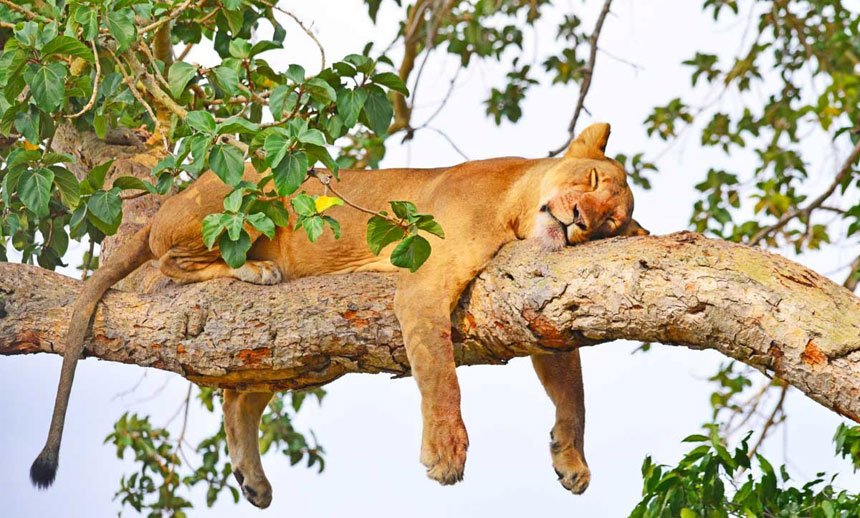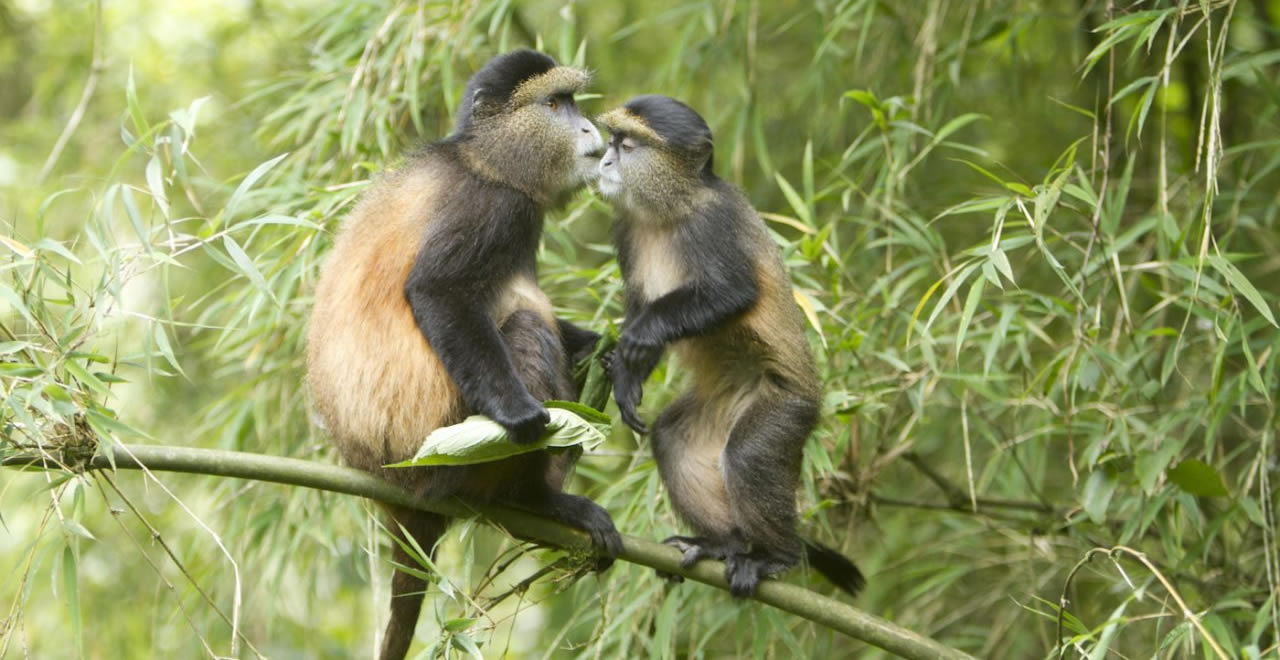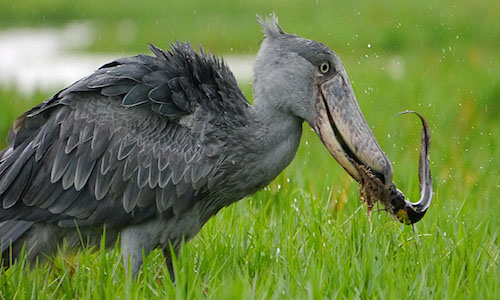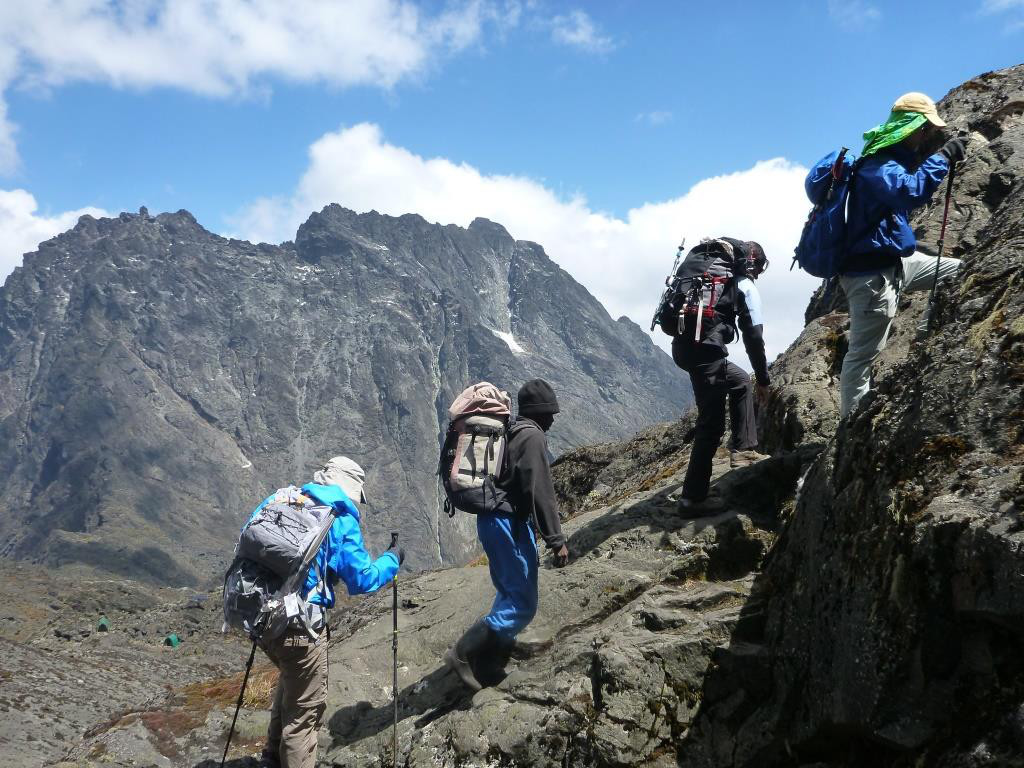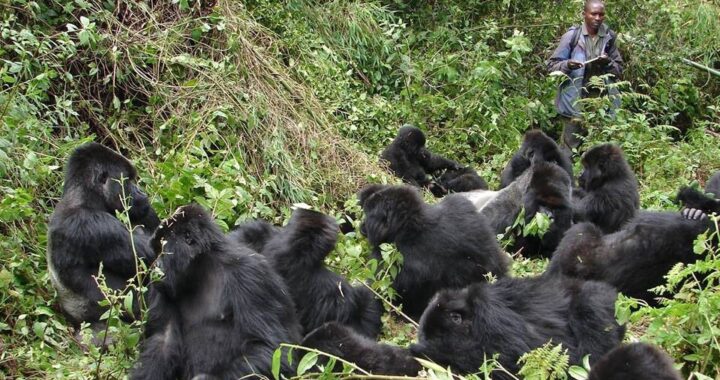Uganda has 23 gorilla families, which is the largest number of habituated gorillas in Africa. Gorilla groups include those meant for gorilla trekking as well as for habituation experience. Mountain gorillas are found in two protected areas including Bwindi Impenetrable Forest national park, a UNESCO world heritage site famous for harbouring 459 mountain gorillas, which is almost half of the world’s mountain gorilla population. Gorillas also live in Mgahinga gorilla national park, which is part of the Virunga Massif, a chain of 8 volcanic mountains that extend for 50 sq.km along the borders of Uganda, Rwanda and DR Congo.
Composition and characteristics of Gorilla families/groups
The general makeup of gorilla families tends to fluctuate from time to time due to several reasons such as migration of members. Therefore, the numbers given in this post are estimated and accurate information is available at the Uganda Wildlife Authority (UWA) information centers as well as tour operators and tour guides. UWA is the official government organization responsible for management of protected areas in Uganda.
Gorilla families in Bwindi impenetrable forest
Bwindi is home to 22 gorilla families of which 2 are reserved for gorilla habituation experience. The park is divided into 4 sectors including Buhoma (park headquarters) with 6 groups, Ruhija in the south east 4, Rushaga 8 and Nkuringo 4. Tracking in each area is a unique experience given that gorillas are never the same and the attractions and scenery are diverse.
Gorilla families in Buhoma sector
Buhoma sector has 6 gorilla families of which 3 were first habituated in 1993 and are still available for tracking. They include Mubare with 12 members, Rushegura 19 and Habinyanja 17. In time more three groups were added including Katwe, Muyambi of 6 and Binyindo.
The Buhoma sector lies at 1,160 meters – the lowest altitude of Bwindi. Trekking in Buhoma tends to be easier due to the nature of terrain. Additionally, the sector contains 2 spectacular waterfalls which are accessible on nature trails. Buhoma is also known for having some of the Albertine Rift Endemics (AREs) species including Chanpin’s flycatcher, short-tailed warbler, red faced woodland warbler, Kivu ground thrush, purple breasted sunbird, and stripe breasted tit.
Mubare
Being among the oldest 3 groups of Bwindi, Mubare is known for being the easiest gorilla family to track. Reason being that the family of 12 members including a silverback is well accustomed to humans and its home range is not far from the gorilla center. The gorillas are oftentimes found feeding along the main trail, on a lucky day, visitors might not need to hike too far. Sometimes, the group tends to come closer whilst feeding to some of the lodges on the edge of the forest such as Mahogany Springs, Sanctuary Forest Gorilla Camp and Buhoma lodge.
Habinyanja
Also known as group H, Habinyanja is Bwindi’s 4th largest gorilla group by composition. The family has 17 members led by a mature silverback, making it ideal for those intending to see many gorillas gathered together. The trail heads to the group’s home range are far from the center and requires taking a short drive first. This means that tracking can be challenging due to the nature of terrain and visitors expect not to return soon.
Rushegura
Rushegura is one of the 3 families to be habituated first in 1993 and has 19 families, making it one of the largest groups in Bwindi. It was named after Kishegura, one of the best UWA ranger guides who discovered the group and also created trails to track it. The group feeds on the slopes of the hill not far from the visitor center, making it easier to track. This is not always the case as the group’s home range is rather large, spanning from the lower slopes above Munyanga river to Mubare hill.
Muyambi
The newest family in Buhoma, Muyambi has 6 members including a silverback. This group was opened for tourism in 2020, thus ideal for those intending to see fresh gorillas that have just passed the habituation process.
Katwe
Katwe group with 11 members is also among the newly habituated in Bwindi. The exact number of its family members keeps on fluctuating, but rangers have observed some of them, including one dominant silverback, adult females, and infants.
Binyindo
The habituation of Binyindo was completed in 2021, and the family has 6 individuals. Unlike other groups, Binyindo’s home range is above the Ivi River trail on the border with Sarambwe Nature Reserve in DR Congo.
Gorilla families in Ruhija sector
There are 4 gorilla groups in the Ruhija sector, which include Bitukura, Kyaguriro, Oruzogo and Mukiiza, which is under research. The sector lies south east of Bwindi impenetrable forest, 53 km (2-hour drive) from Kabale municipality and 41 km (1-hour 54 min drive) from Buhoma, making it easy to combine both sectors for those intending to do double gorilla tracking. Tracking in Ruhija can be challenging given that it lies at the highest altitude of Bwindi 2,607 meters. However, due to a smaller number of accommodation facilities, the sector is secluded and ideal for those seeking to have an off-the beaten gorilla trekking experience.
Bitukura
Bitukura group has 11 members led by a silverback and was the first to be opened for tourism in the Ruhija sector in 2008. For over 10 years, Bitukura is well accustomed to humans. It was named after Bitukura river and the steep valley slopes can be challenging to navigate. However, the home range is closer to the gorilla center, sometimes the gorillas are found along the main road that leads to Queen Elizabeth national park.
Kyaguriro
Kyaguriro has 15 members making it one of the largest gorilla families by composition. Its habituation began in 1999 and the group was kept under research for several years. It was later opened for tourism, according to UWA there are two silverbacks in this family including Rukina the current leader, who ousted an aging silverback known as Zeus. Given that there must be one leader, the rangers are keeping a close eye to see who is going to keep leading the family. It has also been observed that some of the adult females came from the Kyaguriro family as the two groups are neighbors.
Mukiiza
The Mukiiza group split from the Kyaguliro group forming their own in 2016. The family has 15 members including 1 Silverback, 7 Adult females, 1 Sub-adult, and 1 juvenile and 5 infants of which 2 were born in 2021. UWA in partnership with the Manx Planc Institute (MPI) are observing these groups for research purposes. The aim is to study the ecology as well as the physical character and social relations between the gorillas, which might help to understand why it broke away from its parental family. So far, findings indicate the group tends to forage most of the time in the inner parts of the forest.
Oruzogo
Oruzogo at the time of habituation in 2008 had 17 members, which split and only 10 remain today including 1 silverback, 4 black backs, 2 adult females, 1 juvenile and 1 sub-adult and 1 infant. The name Oruzogo refers to a local plant called Alchornea hitela on which the gorillas feed on mostly. According to UWA, this plant isn’t common among the plants that gorillas feed on, yet this family makes it its primary food.
Gorilla families in Nkuringo sector
The Nkuringo sector lies south of Bwindi on the Ndego ridge, about 1 km from Kisoro town council and 76 km from Kabaale municipality. Tracking in Nkuringo is ideal for travelers coming from Rwanda via the Cyanika border town. The word Nkuringo in local Rukiga dialect means “round hill”, the sector lies on Ndego ridge (2,000 meters), which offers views over the Virunga volcanoes and Albertine rift valley, making Nkuringo the most spectacular Bwindi gorilla sector. There are 4 gorilla groups in Nkuringo of which 1 of them called Posho is designated for habituation experience while the other 3 are open for tracking.
Posho
Posho is one of the 2 Bwindi gorilla groups designated for habituation experience, in which visitors spend 4 hours with the primates. The group has 9 members including silverback, which is known for chest thumping when visitors approach.
Nkuringo group
Nkuringo has 12 members including a young silverback Rwamutwe (bullhead) which took over leadership in 2020 after the death of Rafiki killed by poachers. At 25 years old, Rafiki was the oldest silverback recorded in south Bwindi impenetrable forest. The group was the first to be habituated in the Nkuringo sector and it had 20 members at the time. After getting used to human presence, the gorillas developed a habit of marauding in the local community farms. UWA created a buffer zone by relocating people, which addressed the challenge of human-gorilla conflicts.
Bushasho
The Bushaho group has 10 members including the dominant Bahati the silverback. The home range area known as Bushaho is between Rushaga and Nkuringo sectors. The family therefore tends to forage in a large area, where it has interacted with the Nkuringo group in 2012. In fact, Bahati the silverback and some other gorillas left Nkuringo and joined Bushaho. UWA rangers also noticed that there were wild non-habituated gorillas too. Some follow-up exercises were done to ensure that the group is stable for visiting, which has been successful. Among the 10 members, there’s a powerful black back, which might rival Bahati for leadership in future. Visiting the Bushaho group is interesting to see how the two rivals keep distance while feeding. Other gorillas include 3 adults and 2 sub adult females and 3 infants.
Christmas
Chritsmas group has 9 members of which most came from Nkuringo including a wild adult female with a baby. Thus, UWA didn’t spend much time habituating them which eased the work for tracking.
Gorilla groups in Rushaga sector
Rushaga gorilla center is situated in the southern part of Bwindi, 36.9 km (1-hour 26 min drive) from Kisoro airstrip. The sector can also be reached by those traveling from Rwanda. Rushaga has 8 gorilla groups and the largest number of accommodations of which some are perched on the shores of Lake Mutanda and Lake Mulehe, 21.7 km away from the gorilla center. In addition to gorillas, there are several other activities you may do including canoeing, boat riding, forest walks.
Bikingi
Bikingi is the second group undergoing the habituation in Bwindi therefore open for the habituation experience. There are 11 members including a silverback Bikingi, which was killed by an intruding wild silverback in 2018, which took over leadership. The incident caused 9 gorillas to leave and join other groups; 5 adult females later reunited together. The females have been giving birth over the years bringing the total to 11 individuals including 2 silverbacks, 4 infants and 1 juvenile. The habituation process of Bikingi began in 2012 when UWA rangers noticed that both habituated (from Mishaya group) and wild gorillas had joined together. For that reason, the exercise of habituation has been prolonged to keep a close eye on them.
Kahungye
Kahungye is the largest gorilla family in Bwindi impenetrable forest with 25 individuals led by one silverback Ruziika. Seeing such a large number of gorillas gathered together is impressive for keen photographers. UWA began habituating Kahungye in 2008 with roughly 29 individuals of which 3 were adult silverbacks including Riziika, Busingye, and Rwiigi. These have frequently competed against each other with the Silverback Ruziika emerging as the leader. Over the years, the group has expanded with 7 adult and subadult females giving birth to 2 blackbacks, 2 juveniles, and 6 infants.
Nshongi
Formerly the largest gorilla family in the Bwindi Impenetrable Forest National Park, Nshongi had 36 members which later split into Bweza and Mishaya groups due to rivalry among members. Only seven individuals were left which have since increased to 11 including a silverback, black back, 2 juveniles, 5 adult females and 2 infants. The group was named after the Shongi river area, home to several primate species such as black and white colobus monkeys, L’hoest monkeys and olive baboons. Those visiting the Nshongi gorilla group have an advantage to encounter other wildlife in Bwindi Impenetrable Forest national park.
Bweza
The Bweza group separated from the Nshongi in 2010 and was 2 years later recognized and opened for tracking. This made its habituation easier given that most of the gorillas were already fully accustomed to human presence. The group consists of 15 members led by Kakono the silverback, who prefers to forage on the edge of the forest and sometimes moves into the host communities adjacent to Rushaga. Fortunately, the locals are eager to assist in monitoring the primates through the Human-gorilla organization, which empowers locals in conservation.
Mishaya
The Mishaya gorilla group also split from the Nshongi in 2010. It was identified in 2014 with 12 members of which 4 left after the death of the silverback. Currently, Mishaya has 8 individuals including a silverback known as Tinfayo meaning careless in English, 5 adult females, 1 infant and 1 juvenile. UWA discovered that among them were wild gorillas, therefore conducting a thorough process of re-habituating it.
Kutu
One of the biggest gorilla groups in Uganda, Kutu has 20 members and is led by Kutu Silverback. The group consists of 7 Infants, 1 Sub-Adult, 2 Juveniles, 1 Blackback, and 8 Adult Females, which are the recently to be habituated in the Rushaga sector.
Busingye
Busingye meaning peace is one of the 8 gorilla groups in Rushaga sector. It has 9 members including silverback, 3 adult females, 1 black back, 2 juveniles and 3 infants, which tend to forage in the innermost parts of the forest. For that reason, Busingye is considered to be difficult to track in the Rushaga sector.
Gorillas in the Mgahinga Gorilla National Park
Situated in south west Uganda, Mgahinga is part of the Virunga Massif, a chain of 8 volcanic mountains that straddle the borders of Uganda, Rwanda, and DR Congo. This region is home to 604 mountain gorillas of which over 200 individuals are estimated to live in Mgahinga alone. The rest of the gorillas are found in the protected areas including Virunga in DR Congo and Volcanoes national park in northern Rwanda.
In Mgahinga, the Uganda Wildlife Authority has habituated one gorilla family known as Nyakagezi which has 9 members including four silverbacks. The dominant silverback Mark is known for keeping his family within the borders of Uganda. The wildlife rangers also do a great job of monitoring and protecting the group to ensure it doesn’t move beyond the borders. For that reason, travelers planning a gorilla safari in Uganda are encouraged to visit Mgahinga to help reward the efforts of the rangers. Furthermore, given that most visitors go to Bwindi for gorilla safaris, Mgahinga offers an off-the-beaten path experience.


